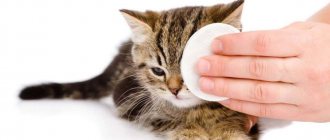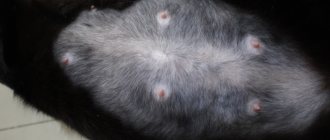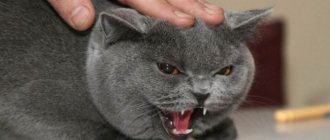5043Pavel
A pathology that causes obstruction of urinary outflow is called renal hydronephrosis. In cats and dogs, this disease is not uncommon. With the disease, the renal pelvis expands, the tissue atrophies, the functioning of the organ gradually deteriorates and, as a result, the animal experiences severe renal failure. The disease can be either congenital or acquired. Since the kidneys are a paired organ, the disease can affect one or two kidneys at once.
With a congenital anomaly, there is underdevelopment of the ureteric tract and pathological expansion of the renal pelvis. Congenital factors cause further development of the disease in cats.
© shutterstock
If the disease is acquired, then usually the following factors become its causes::
- urolithiasis of the kidneys;
- damage and injury to the kidneys and bladder;
- tumors, cysts, dropsy;
- prostate atrophy;
- adhesions;
- surgical interventions, infection.
Main reasons
According to veterinarians, the main source of enlargement of the renal pelvis is considered to be inflammatory processes that negatively affect the structure of the urinary organ.
Hydronephrosis can be unilateral or bilateral, in which one or both kidneys of a cat are damaged. The second form of the disease is more difficult to treat because it leads to more serious structural changes. The development of hydronephrosis is influenced by the following factors:
- mechanical damage that occurs during road accidents, bites of other animals, falls or bruises;
- formation of stones, which is associated with blocking of the ureter by large uroliths;
- malignant or benign tumors in the urinary system that disrupt the outflow of urine;
- abnormal development of the cat’s internal organs;
- insufficient fluid intake or poor quality;
- problems with excess weight;
- complications that arise after sterilization of a pet or other surgical intervention.
Hydronephrosis
Hydronephrosis
- kidney disease, characterized by expansion of the pyelocaliceal system, atrophy of the renal parenchyma and progressive deterioration of all basic functions of the kidney as a result of impaired outflow of urine from the kidney, as well as impaired blood circulation.
In modern practice, there are two types of hydronephrosis: primary and secondary. Primary or congenital hydronephrosis develops due to congenital obstructions in the area of the ureteropelvic segment (ureteric ectopia, stenosis, ureteral atresia).
Secondary or acquired hydronephrosis is usually a consequence of any disease (urolithiasis, tumor of the kidney, pelvis, ureter, bladder, traumatic injury to the bladder, neoplasms of the abdominal and pelvic cavities, prostatic hypertrophy, etc.)
Hydronephrosis can be either unilateral, in which one of the kidneys is affected, or bilateral, in which both kidneys are affected. The presence of an obstruction at the level of the ureterovesical segment leads to the development of unilateral hydronephrosis, and with obstruction in the area of the bladder neck or urethra, bilateral hydronephrosis occurs.
There is a classification of obstacles that arise in various parts of the urinary tract and lead to the development of hydronephrosis:
•Obstructions located in the urethra, urethra, and bladder (uroliths, tumors, clots and hematomas after injuries, etc.)
How does it manifest?
As the disease progresses, the urinary organs work less and less well.
Kidney disease in cats has different symptoms depending on the stage of hydronephrosis. The main stages of the disease and pathological changes are presented in the table:
| Stage | Features of the flow |
| I | The expansion is fixed only from the side of the renal pelvis |
| Pyeelectasis with slight deviation of urinary function is diagnosed | |
| II | The calyxes of the kidneys also expand |
| The cat suffers from a decrease in the thickness of the parenchyma, which reduces its functionality | |
| The efficiency of the internal organ drops to 40% | |
| III | Severe atrophy of kidney tissue |
| Kidney function is completely lost |
At the initial stages, owners are not always able to identify hydronephrosis in a timely manner and consult a doctor. Symptoms tend to occur in later stages, when the disease is more difficult to treat. The following pathological signs are characteristic of the disorder in cats:
With this pathology, the animal may have an elevated body temperature.
- enlarged abdominal cavity;
- increase in pet's body temperature;
- refusal of food;
- bloody spots in the urine;
- delayed urination.
Diagnosis of the disease
Kidney pathology can only be diagnosed by ultrasound, which will show dilation of the pelvis. This method also allows you to determine the size, obstacles, inflammation and neoplasms in the urinary system that have led to a violation of the outflow of urine.
If kidney pyeloectasia is caused by inflammation or infections, the patient must undergo a full examination, which includes:
- Excretory urography is a type of x-ray diagnostics with the introduction of contrast (urografin) into the cubital vein. Urografin is quickly absorbed and accumulates in the urine 5 minutes after its administration. The enveloping effect of contrast allows you to carefully study the condition and functions of the urinary system.
- Cystography is a type of endoscopic examination in which a probe equipped with a video camera is inserted through the urinary tract into the bladder. This method allows you to study the walls and condition of the bladder.
- Radioisotope scanning is a research method that allows you to identify malignant neoplasms and metastases. Also performed before surgery. To do this, the patient is injected with a special substance that accumulates in oncological formations.
Diagnostic procedures
To identify hydronephrosis, you need to contact a veterinary clinic, since it is almost impossible to determine kidney disease on your own, especially in the early stages. The veterinarian conducts a visual examination of the pet and collects a detailed medical history. It is possible to establish the causes of the pathological process and the degree of hydronephrosis using the following diagnostic procedures:
- ultrasound diagnostics of the kidneys;
- radiography;
- contrast excretory urographic examination;
- laboratory urine test.
Prevention
If you have even the slightest suspicion of kidney failure, you need to contact your veterinarian as soon as possible and not waste precious time. Medical examination of older animals, carried out annually, is also an excellent preventive measure. The cat’s owner may not notice signs of the disease, while a specialist will recognize it at the initial stage. Particular care must be taken if the pet owner is going to feed him new, unusual food.
Among the preventive measures, I would like to point out that you should not feed your pet food from the common table. It is unknown what components it consists of and how safe it is. Please note that barely noticeable signs appear when almost 2/3 of the tissue of the internal organs has already undergone changes. You can collect urine in advance and take it with you to the clinic. After the examination, the doctor will prescribe a treatment regimen, depending on the diagnosis.
Necessary treatment
According to veterinarian I. G. Sharabrin, treatment of hydronephrosis in cats of the bilateral type is not effective, while the unilateral type of the disease can be cured with early diagnosis.
Most often, this pathology requires surgical treatment.
As a rule, the main therapeutic measure is surgery, in which the affected paired organ is completely or partially excised. A urorostomy is often performed, and in a more advanced form a kidney can be removed. Such radical surgery is indicated in the following cases:
- atrophy of the renal parenchyma;
- hemodynamic problems;
- urine retention;
- ineffectiveness of drug therapy.
Cats diagnosed with hydronephrosis need to monitor their diet and also take medications. Treatment helps relieve the unpleasant symptoms of kidney disease and improve urinary function. Such therapeutic measures are required not only in the early stages of the pathological process, but also after surgery.
Diet
If a pet gets sick, it needs to be fed properly. Diet therapy is part of a comprehensive treatment for the disorder. It is prescribed when the cat’s well-being improves and the symptoms subside.
Diet with a reduced content of phosphorus and protein brings great benefits. This is due to the fact that insufficiency in the urinary system causes the accumulation of these components. But do not try to feed your pet yourself without consulting your veterinarian.
If a malfunction in the functioning of internal organs leads to the loss of a large amount of protein, it is necessary to compensate for it. But if you feed your pet food that contains too much of it, this can negatively affect the dynamics.
Modern manufacturers offer special diets for the treatment and prevention of kidney failure.
These are the best foods to feed your cat. These are “Eukanuba”.
How to warn?
To prevent cats from being disturbed by the symptoms of hydronephrosis, owners need to carefully monitor the pet and follow some preventive recommendations:
Excess weight in an animal causes disturbances in the functioning of many organs.
- Control your pet's diet. It is necessary to include foods filled with vitamins in your daily diet. It is strictly forbidden to give cats salty, spicy, sweet foods, especially if they are at risk of developing hydronephrosis.
- Drinking quality water. It is not recommended to give your animal liquid from the tap, preferably filtered or bottled water, which does not contain negative substances that settle in the urinary system.
- Avoiding hypothermia. The place where the cat sleeps should be warm and comfortable.
- Timely deworming of your pet. Worms are a common cause not only of the development of hydronephrosis, but also of other serious diseases.
- Avoid mechanical damage that could damage the integrity of the kidneys and other internal organs.
- Weight control. Problems with excess body weight in cats often cause dilation of the renal pelvis and other health problems.
What to do if your cat has hydronephrosis of the kidneys?
A pathology that causes obstruction of urinary outflow is called renal hydronephrosis. In cats and dogs, this disease is not uncommon. With the disease, the renal pelvis expands, the tissue atrophies, the functioning of the organ gradually deteriorates and, as a result, the animal experiences severe renal failure. The disease can be either congenital or acquired. Since the kidneys are a paired organ, the disease can affect one or two kidneys at once.
With a congenital anomaly, there is underdevelopment of the ureteric tract and pathological expansion of the renal pelvis. Congenital factors cause further development of the disease in cats.
If the disease is acquired, then usually the following factors become its causes::
- urolithiasis of the kidneys;
- damage and injury to the kidneys and bladder;
- tumors, cysts, dropsy;
- prostate atrophy;
- adhesions;
- surgical interventions, infection.
What are the forecasts?
Timely diagnosed pyeloectasia in cats gives a great chance of complete relief from the pathology and the return of the pet to its normal life. If it was not possible to timely identify hydronephrosis and begin treatment, or therapeutic measures are selected incorrectly, then the disease becomes more complicated. Significant changes in the urinary system often occur that cannot be treated and lead to renal failure and premature death of the cat. To prevent such an outcome, it is necessary to exclude self-medication at the first sign and take your pet to a veterinarian.
Symptoms and consequences
Left-sided and right-sided pyelectasis with moderate and moderate severity develop asymptomatically, which complicates the diagnostic process. Bilateral pyelectasis may be accompanied by a more severe symptomatic picture.
- The gradual destruction of kidney tissue is characterized by an increase in the volume of connective tissue.
- A decrease in volume and disruption of the outflow of urine leads to a gradual accumulation of harmful substances and compounds.
- Inflammation of the kidneys develops against the background of impaired urine outflow, accumulation of decay products and a decrease in the resistance of the body's immune forces.
- Decreased or complete impairment of kidney function.
Manifestations of pyelectasis in adults:
- Ectopic urethra is a disorder of the structure of the urinary tract, in which the ureter has an outlet into the urethra in men and into the vagina in women.
- Urethrocele is compression of the urethra and narrowing of its opening.
- Disturbance of the urethral valves.
- Ureterovesical reflux is characterized by the reflux of urine into the kidney in the presence of obstacles to its outflow.
- Megaureter develops against the background of urethrocele, which increases bladder pressure.










